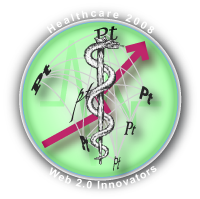How Blogs and Wikis Add Value in Global Organizations by Supplementing Enterprise IT—Contagious Grassroots Enthusiasm
 Healthcare systems worldwide are criticized for falling short of expectations, and countries like the U.S. which feature aging populations, are rapidly approaching a crisis. Demand and cost will grow, but the system as currently structured will certainly break down unless radical changes are made. Web 2.0’s disruptive potential can be part of the remedy: we need to introduce much more accountability and collaboration into all parts of the system. We need to change the paternalistic attitudes that pervade the system, treat patients as active participants and encourage everyone to be more accountable. This series introduces healthcare Web 2.0 innovators.
Healthcare systems worldwide are criticized for falling short of expectations, and countries like the U.S. which feature aging populations, are rapidly approaching a crisis. Demand and cost will grow, but the system as currently structured will certainly break down unless radical changes are made. Web 2.0’s disruptive potential can be part of the remedy: we need to introduce much more accountability and collaboration into all parts of the system. We need to change the paternalistic attitudes that pervade the system, treat patients as active participants and encourage everyone to be more accountable. This series introduces healthcare Web 2.0 innovators.
Business Drivers
Pfizer is the world’s largest pharmaceutical company by sales, having in its stable numerous bestselling drugs, from Lipitor, Lyrica and Diflucan to Zithromax and Viagra. It also has the industry’s largest R&D budget, a global workforce and a tremendous need for its people to collaborate seamlessly across boundaries.
All pharmaceutical companies are struggling to invent new drugs because much of the “low hanging fruit” has been harvested, and their R&D staffs need to try new things to discover and bring new drugs to market.
In this case, Pfizer’s experience suggests the power of applying Web 2.0 tools internally, a practice termed “enterprise 2.0.”
Summary of Web 2.0 Activities
 It All Began with a Blog..
It All Began with a Blog..
Pfizer’s enterprise 2.0 journey began as a grassroots effort. The company’s most visible champion, Simon Revell, was frustrated by the inefficiency of collaboration, so he connected with several other people who felt the same and decided to do something about it. They launched a blog, and they made it open to all employees.
It turns out that they hit an inflection point. Several months later, they organized an internal Web 2.0 conference, and they shared it live via Web 2.0. They received 300,000 hits on the conference website. They created blogs and podcasts to share event happenings worldwide.
Since then, they have created an online community in which employees can help each other to learn Web 2.0 tools and to apply them to business processes. Several months after that, Revell was then asked by IT management to present the case. He says, “We’re getting so many doors opened to us now and so many opportunities to try out this stuff,” he said. “So many people are keen to look at it and examine it.”
.. Followed on with a Wiki
Meanwhile, Chris Bouton, a researcher at Pfizer’s Research Technology Center, introduced a wiki to help connect the dots. Many researchers resemble software builders; they like to work in tight groups without extensive interaction, but Bouton is cut out of a different cloth. Having an appreciation to connect people and ideas, he tried to help his colleagues create and share information. “Basically what I did,” he says, “was download MediaWiki, the open-source software that runs Wikipedia, onto a computer under my desk and press the on button.”
The rest is history. Pfizerpedia, as the wiki became affectionately named, grew virally, amassing 13,000 individual users worldwide within a year of launch. Pfizer has discovered that wikis are very powerful collaboration tools because they enable colleagues to post content and correct each other’s content. It has also become a resource to help colleagues embrace other Web 2.0 technologies in general.
.. and Continues with Plans for a “Pfacebook”
Simon Revell, the blog champion, is promoting numerous Web 2.0 technologies by exploiting Microsoft SharePoint’s Web 2.0 features such as RSS feeds to enable colleagues to subscribe to very granular content, significantly reducing unwanted email.
Borrowing a page from the success of “Pfizerpedia,” they are planning to launch their own social network. He remarked, “We have a whole bunch of content inside of Pfizer that we want to expose (share). We have a lot of internal Web sites, Internet sites and apps. Moreover, anyone in any role has to touch quite a few of them in their work. Users can see when folks are reading content.”
Lessons Learned
- In most cases, when enterprise 2.0 initiatives are taking place within the firewall, CIOs’ best course of action is often to lay down some broad boundaries—and then get out of the way. Motivated employees can work wonders, and the use of Web 2.0 tools often spreads virally.
- Web 2.0 tools are ideal for “filling in the gaps” between other collaboration resources; they do not depend on other technologies to function.
- Wikis, blogs, bookmarking and RSS usually represent modest investments; Pfizerpedia started on an old machine under a desk.
- Unlike traditional “enterprise” applications, Web 2.0 software usually works out of the box; it doesn’t require expensive customization and IT resources to launch and manage.

[…] post Pfizer: Healthcare Web 2.0 Innovator Case Study appeared first on Christopher S. Rollyson and […]
[…] post Pfizer: Healthcare Web 2.0 Innovator Case Study appeared first on Christopher S. Rollyson and […]